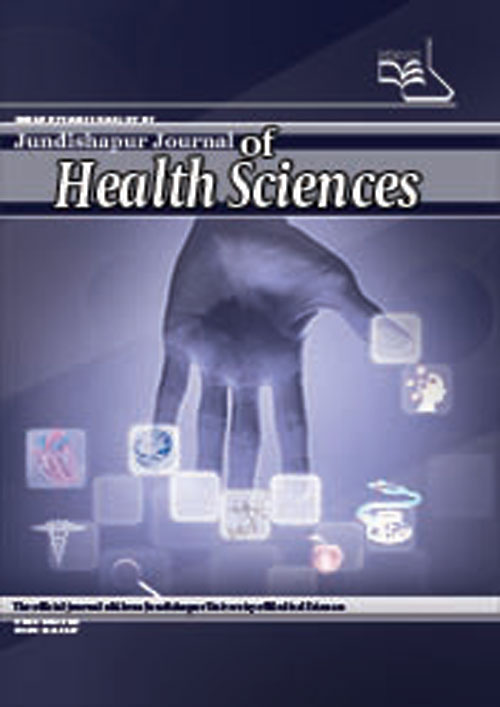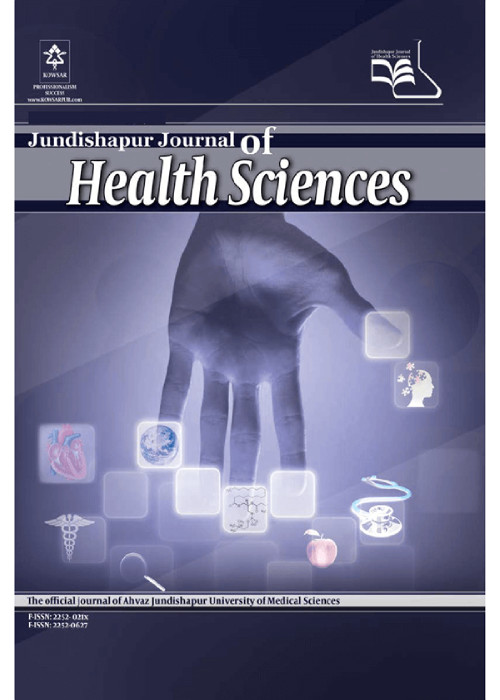فهرست مطالب

Jundishapur Journal of Health Sciences
Volume:11 Issue: 2, Apr 2019
- تاریخ انتشار: 1398/02/22
- تعداد عناوین: 6
-
-
Page 1BackgroundEntrance of heavy metals into the respiratory system has adverse effects on human health. Accordingly, measuring metals concentration in places and times is necessary.ObjectivesThis study was done to evaluate the non-carcinogenic risk of Pb, Cd, and As in air suspended particles of Baharestan city, in Isfahan, during 2016 - 2017.MethodsIn order to evaluate the non-carcinogenic risk of heavy metals in air suspended particles (PM10), sampling was performed using a SKC pump with a low volume (1.5 L/min) and 37 mm membrane filter. Sampling was carried out on average every three days during 24-hours in May - June, July - August, October - November, and January - February; finally, the concentration of Pb, Cd, and As was determined using atomic absorption spectrometry (AAS) and hydride generation atomic absorption spectrometry (HGAAS), respectively. The acute and chronic non-carcinogenic risk of heavy metals sorption in the air was evaluated using the EPA method.ResultsThe highest and lowest Pb concentration belonged to May - June and October - November, with the mean concentration of 0.25 and 0.14 mg/kg, respectively. For Cd it was 0.017 and 0.009 mg/kg, respectively. Similar results were found for the air suspended particles. The highest and lowest Cd non-carcinogenic risk was observed for permanent residents of Baharestan city and the non-dormitory students of this city with the mean of 3.1 × 10-5 and 1.4 × 10-5, respectively.ConclusionsThe results of this study showed that the non-carcinogenic risk of heavy metals was lower than the standard level during the study years. However, heavy metal accumulation can threaten human health, which needs more consideration.Keywords: Non- Carcinogenic Risk, Pb, As, Cd, Baharestan
-
Page 2BackgroundIn order to assess the cardiorespiratory condition of people and as a result to create a physiological symmetry between work and worker, physical work capacity is of high importance and can play a special role in choosing qualified workforce.ObjectivesThe current study aims to evaluate work capacity and examine the effect of body mass index (BMI) and body fat percentage (BFP) on aerobic capacity.MethodsIn this cross-sectional study, 50 male university students voluntarily participated. Work capacity was measured with the use of a treadmill and the Bruce protocol. BMI and BFP, as the variables of the research, were measured using the device while the subjects were undergoing the test. The relationship between the variables was investigated using the Pearson correlation test.ResultsThe mean and standard deviation of age for the people under the study was obtained as 21.36 ± 2.08 years. The mean and standard deviation of the aerobic capacity was estimated at 44.01 ± 4.75 (mL/kg/min). The results showed that there was a significant inverse relationship between BMI, BFP, and Maximal oxygen consumption (VO2max). The level of significant was set as 0.05 (P ≤ 0.05).ConclusionsThe findings indicated that BMI and BFP, as the variables, were effective factors in the people's aerobic capacity. These indices can be used as a criterion for determining the aerobic capacity of people.Keywords: Physical Work Capacity, Body Mass Index, Body Fat Percentage, Treadmill Test
-
Page 3BackgroundCadmium is one of the heaviest metals in the natural environment that can increase DNA damage in liver cells, nevertheless, it has been reported that physical activity and nutrition can improve the damage of DNA in liver cells.ObjectivesThe aim of the present research was to review the effect of interval training and selenium on cyclin-D and caspase-3 gene expression in liver tissue of cadmium-exposed rats.MethodsIn the present experimental research, 30 rats were divided to six groups of (1) control, (2) sham, (3) cadmium, (4) selenium consumption with cadmium, (5) interval training with cadmium consumption, and (6) interval training with selenium and cadmium consumption. For eight weeks, groups three to six received 2 mg/kg of cadmium per day; groups four and six consumed 0.23 mg/kg of selenium per day and groups five and six performed three sessions of selected interval training per week.ResultsCadmium consumption significantly increased cyclin-D and caspase-3 (P = 0.001); selenium consumption and interval training had a significant effect on decreasing caspase-3 and cyclin-D levels (P = 0.001); concurrent interval training with selenium consumption had interactive effects on the increase of cyclin-D (P = 0.001). However, there was no interactive effect on the reduction of caspase-3 (P = 0.75).ConclusionsIt seems that interval training with selenium consumption has interactive effects on hepatocyte apoptotic factors in rats exposed to cadmium.Keywords: Training, Selenium, Caspase-3, Cyclin-D, Cadmium
-
Page 4BackgroundToday, the prevalence of obesity is seen as a major social challenge, affecting the general health of societies, which creates irreversible psychological, social, and economic consequences. In this regard, exercise training is one of the most important interventions in preventing and controlling obesity and the associated metabolic factors, which can be an appropriate and low-cost option for promoting community health and to some extent, managing metabolic diseases.ObjectivesThe present study was aimed at evaluating the impact of eight weeks of aerobic exercises on the levels of oxidized LDL cholesterol (Ox-LDL) and cardiovascular risk factors among obese and overweight females.MethodsThis study was conducted in Gachsaran, Iran in 2018. Following a public call for inclusion as part of this quasi-experimental study, 22 obese women who met the inclusion criteria that was set for the study were chosen and were then divided into experimental (exercise training) (n = 11) and control (n = 11) groups. The subjects in the experimental group ran for eight weeks, three sessions per week for 45 minutes at an intensity of 55% to 65% of maximal oxygen consumption (Vo2max). Independent and paired sample t-test were used to account for the variations. For statistical analysis SPSS-21 software was used, and the significance level was set to be less than P < 0.05.ResultsThe findings indicated that the participants’ body mass indices in the experimental group significantly decreased (P < 0.001). In addition, it was found that insulin resistance (HOMA-IR), insulin, glucose and lipoproteins (LDL-TC-TG), and C-reactive protein (CRP) were significantly diminished (P < 0.001), whereas the high-density lipoprotein (HDL) level went up (P < 0.001) following the treatment. No significant changes in Ox-LDL were found after eight weeks of aerobic exercise training (P = 0.07).ConclusionsIt seems that eight weeks of exercise training with decreasing anthropometric indices, CRP levels, and insulin resistance, even without changing the levels of Ox-LDL, can prevent obesity and metabolic complications.Keywords: Aerobic Exercise, Oxidized LDL Cholesterol (Ox-LDL), Cardiovascular Risk Factors, Obese Women
-
Page 5BackgroundDust storms affect a wide range of arid or semi-arid countries every year and thus impose a threatening health risk to the affected people whether young or old. Children are regarded as a high-risk group in public health concerns.ObjectivesThe aim of this study was to evaluate the relationship between occurrence of dust storms on schoolchildren’s health and school absenteeism.MethodsThe study was performed from October 2016 to June 2017 in Ahvaz. Fifty primary schools with 4200 pupils in total participated in the study. Data was collected by a questionnaire.ResultsThe highest number of absenteeism happened after the first dust storm with 885 absent students from a total of 3486 (25.36%), with mostly one day absence duration. The difference between absenteeism rates of boys and girls in different schools was evaluated. The results showed a significant difference between boys and girls in both kinds of schools and amounts of absence days.ConclusionsIt can be concluded that dust storms and exposure to high levels of particulate matter can increase the frequency of respiratory symptoms and illnesses in schoolchildren and consequently more children cannot attend school.Keywords: Absenteeism, Schoolchildren’s Health, Dust Storms
-
Page 6ObjectivesThe present study aimed at examining the relationship between the Enneagram personality types and health responsibility in patients with substance use disorder (SUD).MethodsThe current cross sectional study was conducted on 68 patients with SUD referred to methadone maintenance treatment clinics in Kermanshah city, Western Iran, in September 2017. The Riso-Hudson Enneagram type indicator (RHETI) and subscale of health responsibility from the health promoting lifestyle profile (HPLP-II) were used for data gathering. The obtained data were analyzed using Pearson correlation and multiple linear regression analysis.ResultsThe mean ± SD age of the samples (100% male) was 39.4 ± 13.3 years. The obtained results showed a significant direct relationship between personality types 1 and 3 and health responsibility, while the same relationship was indirect for the personality type 4 (P < 0.05). Despite the inability of the three personality types in predicting health responsibility, the model generally could explain 12.5% of the variance in criterion variable.ConclusionsProbably, screening the personality patterns of patients with SUD using the Enneagram model can be useful to identify vulnerable groups. Since SUD rehabilitation includes long-term formal nursing services, training should be focused on improved health responsibility among risk-taking personalities such as type 4.Keywords: Healthy Lifestyle, Personality, Rehabilitation Nursing, Substance Use Disorder


